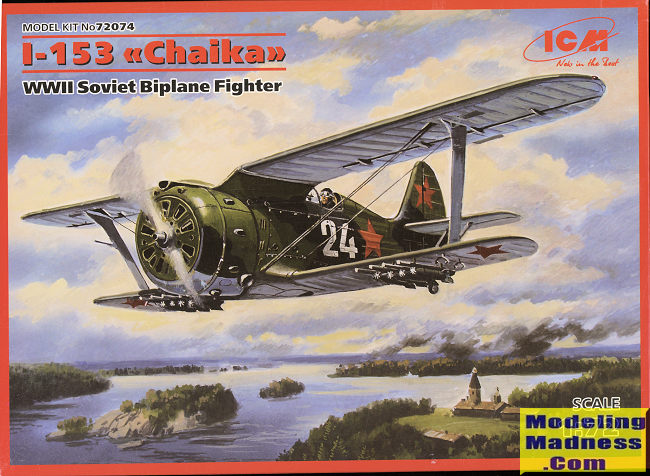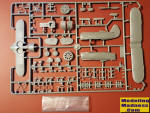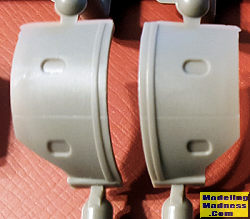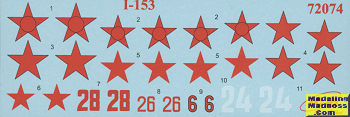
| KIT #: | 72074 |
| PRICE: | $11.98 plus $8.00 shipping from Kiev |
| DECALS: | Four options |
| REVIEWER: | Scott Van Aken |
| NOTES: | Initial release in 2014 |

| HISTORY |
The Polikarpov I-153 Chaika (Russian Чайка, "Seagull") was a late 1930s Soviet biplane fighter. Developed as an advanced version of the I-15 with a retractable undercarriage, the I-153 fought in the Soviet-Japanese combats in Mongolia and was one of the Soviets' major fighter types in the early years of the Second World War. Three I-153s were pulled from Russian swamps, completely rebuilt and are still flying.
The I-153 first saw combat in 1939 during the Soviet-Japanese Battle of Khalkin Gol in Mongolia. The Japanese Army Air Forces' Type 97 Fighter (Nakajima Ki-27) Nate proved a formidable opponent for the I-15bis and I-16, but was more evenly matched with the I-153, which retained agility inherent to biplanes while featuring improved performance. While the overall I-153 performance was satisfactory, some significant problems were revealed. Most troublesome was the absence of a firewall between the fuel tank mounted in front of the cockpit and the pilot. Combined with strong draft coming in through the wheel wells, fuel tank fires invariably resulted in rapid engulfment of the cockpit and severe burns to the pilot. In addition, the M-62 engine suffered from a service life of only 60–80 hours due to failures of the two-speed supercharger.
The Polikarpov I-153 Chaika never flew with any Spanish Air Force units during or after the Spanish Civil War. Two earlier variants of this aircraft, the I-15 and the I-15bis, did fly with the Republican Air Force during the conflict and, later, captured examples of both types were used by the Fuerzas Aéreas till the early 1950s.
| THE KIT |
 To
my knowldege, the ICM kit of the I-153 is only the second time this aircraft has
been kitted by a major manufacturer in this scale. Previously we had the Heller
kit. That kit was quite nice for the time and despite a fairly vacant cockpit
and landing gear struts that were fairly crude, makes into a nice model. It does
have one plus over the ICM kit in that it has actual exhaust where this
kit provides only the openings.
To
my knowldege, the ICM kit of the I-153 is only the second time this aircraft has
been kitted by a major manufacturer in this scale. Previously we had the Heller
kit. That kit was quite nice for the time and despite a fairly vacant cockpit
and landing gear struts that were fairly crude, makes into a nice model. It does
have one plus over the ICM kit in that it has actual exhaust where this
kit provides only the openings.
When you finally get the box open, you'll find a single sprue with a small clear windscreen. ICM has gone the route of Zvezda by providing a 'lunch box' style box with a thin cardboard box cover. However, the kit box has a tab that locks in place. Pulling it to open the box will rip both the lid and the area of the box that accepts the tab. This is due to the rather low grade cardboard they use. I recommend cutting the closing tab right away. There are side tabs that are sufficient to keep the box closed.
You are provided with a nice interior that includes all the framework around the edges. This then fits on a floor pan that accepts the seat, rudder pedals and control stick. The assembly then fits atop the lower wing. The fuselage halves are joined and this is then fit atop the lower wing. Engine construction is next. Most of it will be hidden behind the front cowling plate that is part of the forward cowling. Engine is then attached to the forward cowling and the prop is attached.
 Wing struts
are attached and the upper wing is glued in place along with the horizontal
stabs. The rest of the engine cowling (the part with the exhaust openings)
accepts the forward cowling and is glued onto the airframe. Here is a photo of
these cowling pieces showing that there are no exhaust pipes, nor are any
included in the kit. One then attaches the main landing gear. Attachment points
are well defined, unlike the Heller kit. Gear doors are glued on as are the wing
rocket rail or bombs. Holes are opened for either choice. Last thing is to rig
it and ICM provides a diagram.
Wing struts
are attached and the upper wing is glued in place along with the horizontal
stabs. The rest of the engine cowling (the part with the exhaust openings)
accepts the forward cowling and is glued onto the airframe. Here is a photo of
these cowling pieces showing that there are no exhaust pipes, nor are any
included in the kit. One then attaches the main landing gear. Attachment points
are well defined, unlike the Heller kit. Gear doors are glued on as are the wing
rocket rail or bombs. Holes are opened for either choice. Last thing is to rig
it and ICM provides a diagram.

Instructions are well done with Model Master paint references. There are four options. One is in overall aluminum lacquer with dark green mottling all over the upper and side surfaces. This plane fought at Kalinin Gol in 1939. Second is an overall aluminum lacquer plane that fought in Lithuania in 1941. Next a yellow tailed plane from 1941 with the northern fleet. This one is dark green over light blue-grey. Finally, the box art plane from the summer of 1942. Decals are nicely printed and should work fairly well.
| CONCLUSIONS |
For the most part, this is the kit to have for this aircraft in this scale. Not that the Heller kit is 'bad', but it is outdated. Highly recommend forking over the bucks for the SBS exterior correction set that includes a new engine cowling and rudder along with photo etch bits.
| REFERENCES |
https://en.wikipedia.org/wiki/Polikarpov_I-153
November 2020
Copyright ModelingMadness.com. All rights reserved.
If you would like your product reviewed fairly and fairly quickly, please
contact
the editor or see other details in the
Note to
Contributors. Back to the Main Page
Back to the Review
Index Page
Back to the Previews Index Page